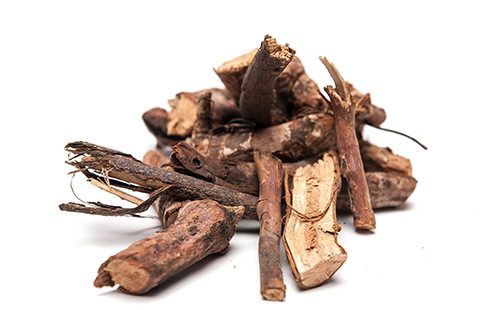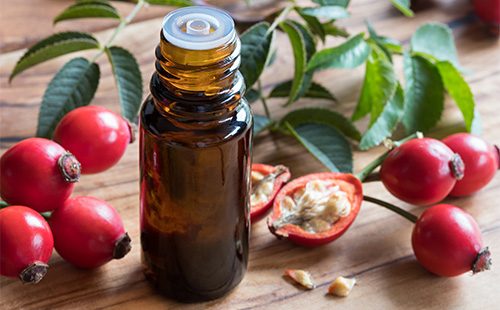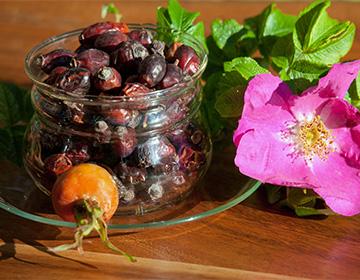The content of the article
In Tibet, there is a belief that the spirit of the mountains lives in the roots of a wild rose. It is he who has power over the stones and expels them from the human body. Actually a little more prosaic. The content of phenolic compounds and organic acids in raw materials has been scientifically proven, which facilitate the excretion of bile and urine, preventing the formation of calculi. The activity of plants against existing deposits is considered by traditional medicine to be a phenomenon. However, the effectiveness of the tool in this regard has been verified by centuries of folk experience.
Composition
Cholagogue and diuretic properties, as mentioned above, rose hips owes to the content of organic acids and phenol-containing compounds. They stimulate the secretory activity of the gallbladder, relax smooth muscles. Improving the secretory function prevents stagnation, which are the main cause of the formation of stones.
Assistance in the process of establishing metabolism is also provided by other substances:
- flavonoids;
- glycosides;
- vitamins;
- minerals.
Flavonoids help strengthen blood vessels, prevent vascular spasms, and normalize blood circulation. Glycosides exhibit a mild hypotonic effect. Among the nutrients rich in raw materials - ascorbic and nicotinic acids, B vitamins, carotenoids, rutin and vitamin K. Also in the rose there are many minerals: salts of manganese and magnesium, potassium, phosphorus, iron, calcium. Due to this, the plant has a positive effect on metabolism and the state of the body as a whole - strengthens the immune system and nervous system.
Rosehip roots are a source of tannins. On the surface of injured skin and mucous membranes, they react with proteins, forming an albuminous film. Thus, the following actions appear:
- regenerative;
- enveloping;
- hemostatic;
- anti-inflammatory;
- antimicrobial.
Benefits for the body
This raw material is used as a substitute for regular tea. The drink improves metabolism, strengthens the body, increases resistance to infections and has a tonic effect. The use in folk medicine of the underground parts of the rose is relevant in a number of pathological conditions.
- Digestive apparatus diseases. Mostly phytochemicals are used for stones in the gall bladder, as well as for the prevention of their occurrence. Raw materials improve liver function, helps restore detoxification function. The medicinal plant has an anti-inflammatory effect for diarrhea, including an infectious one. It is used in the complex treatment of pancreatitis, as it can stimulate secretory function.
- Gynecological pathology. The use of raw materials is useful for uterine bleeding, as well as for heavy menstruation. Vitamin K regulates blood coagulation. As an external agent, it is used for infectious and inflammatory lesions of the mucous membranes.
- Kidney disease. Anti-inflammatory and diuretic actions allow the plant to be used for inflammation of the kidneys and urinary tract. It is also recommended as a part of diuretic collections to facilitate dissolution and successful removal of stones and sand.
- Diseases of the Ode. Due to the systemic anti-inflammatory effect, the raw material helps to cope with damage to the joints and ligaments. The plant is used internally and externally for gout, arthritis, radiculitis, myositis, arthrosis. Wild rose establishes mineral metabolism, preventing the development of osteochondrosis and facilitating its course.
- Diseases of the cardiovascular system. The underground part of the culture has long been used to normalize the work of the heart - reduce pressure, optimize heart rate, strengthen the vascular walls, eliminate migraines and normalize blood circulation. Nutrients improve hematopoiesis, prevent the development of anemia. The tool is used both for treatment and for the prevention of problems with blood vessels.
- Men's problems. With the help of rose hips, congestion is eliminated and the blood supply to the pelvic organs is optimized. This prevents a decrease in potency, improves the functioning of the genital glands, and helps to treat prostatitis.
- Skin problems. Raw materials have a beneficial effect on the condition of the skin, accelerating their regeneration, eliminating pathogenic microorganisms. It is used to treat injuries, psoriasis, eczema, with itchy skin, as well as to eliminate cosmetic problems - pigmentation, acne, acne. As an anti-inflammatory drug used for varicose veins, vasculitis, hemorrhoids.
In ancient times, the means prepared on the basis of the roots of the rose, treated places of bites of wild animals. Hoods were also prescribed inside, because the plant removes poisons and toxins from the body. Today, the cleansing properties of raw materials are relevant for weight loss and light intoxication.

Contraindications
Moderate intake of drugs based on phyto-raw materials is very well tolerated. The plant rarely provokes allergies. However, the recommended dose should not be exceeded. This is fraught with side effects:
- digestive disorders;
- nausea;
- headache;
- excessive decrease in blood pressure.
The main contraindication is individual sensitivity to the plant. It can also be harmful in the presence of the following pathologies:
- hepatic, cardiac, renal failure;
- acute inflammatory lesions of the kidneys and gastrointestinal tract;
- clotting disorders, thrombophlebitis;
- hypotension and VVD by hypotonic type.
Billet
For the preparation of medicines, the underground parts of the culture can be purchased at a pharmacy, from herbalists, or prepared on their own. In the latter case, it is important not only to collect a sufficient amount of raw materials, but also not to harm the plant.
- Collection. Raw materials are procured outside the period of sap flow - in early spring or late autumn. The shovel is dug up with a shovel on one side. Only lateral branches from the central core root are of medicinal value. In places of branching, they are carefully broken off or cut off.
- Training. Before drying, the collected raw materials should be washed quickly in cold water, and then dried from excess moisture in the air in the shade. Then it is cut into pieces up to 2 cm. The discarded areas are discarded.
- Drying. The raw materials are laid out in a thin layer on a paper-coated pallet. They are placed under a canopy with through ventilation. Quick drying ensures the preservation of nutrients.
Prescription Drugs
Herbalists recommend brewing raw materials with black or green tea. It turns tonic and restorative drink. It tastes good and contains vitamins. According to special recipes, stronger preparations are prepared.
Decoction
Features With kidney stones and gall bladder, traditional healers prescribe a decoction. A concentrated product can be used to prevent stagnant processes, reduce blood pressure, and treat diarrhea. The drug is also used in the form of lotions for the night with skin ailments.
Preparation and use
- A couple of tablespoons of crushed roots is poured with two glasses of boiling water.
- The mixture is put on fire, brought to a boil.
- With minimal drilling, they languish for 15 minutes.
- After complete cooling (two hours later) filter.
- Use half a glass three times a day before meals.

Tincture
Features Alcohol extract is used as an anti-inflammatory agent of systemic action - for the treatment of joint diseases, elimination of swelling, normalization of metabolism.
Preparation and use
- 20 g of powdered roots are poured into a glass of quality vodka.
- The container is tightly closed, shaken.
- Leave to insist in a dark place, shake regularly.
- After two weeks, filter.
- Take inside a teaspoon three times a day.
To enhance therapy for joint diseases, baths with herbal remedies are recommended. Use a decoction (a glass of raw materials in 2 liters of water). After complete cooling, the product is added to the bath with warm water. Such procedures help to eliminate the symptoms of rheumatism and dystrophic lesions of the joints, the disappearance of seizures, alleviating the condition of the patient with paralysis. In addition, they tighten the skin, reduce sweating, and clear of rashes.

